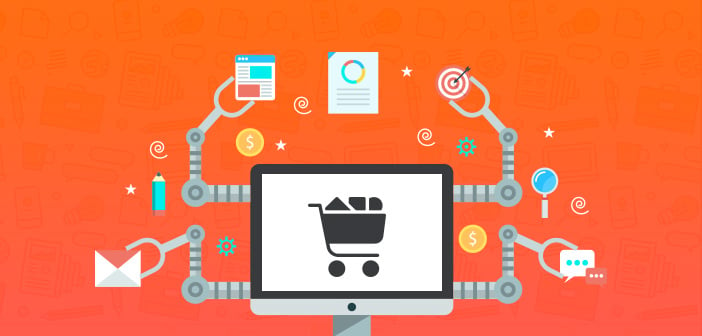How to Automate Your eCommerce Business with AI Technology in 2020
Posted by Matthew Fritschle
Updated: Jan 16, 2020

Artificial intelligence is like that one person you keep on running into everywhere you go. After all, it’s in the palm of your hand as a smartphone, in your car as a navigation system, and in your home as a thermostat, vacuum cleaner, or even a refrigerator. The point being that no matter where you go, AI is there to lend a helping hand. As it happens to be, this includes the online world and, our main discussion point for today, eCommerce.
The Application of Artificial Intelligence in eCommerce
So, how can AI help a business? The application of AI in eCommerce is doubly beneficial because it helps both you, the business owner, and your audience, the customers. On the one hand, you can use AI to create chatbots that take care of your users 24/7 and streamline the journey to checkout; on the other, your users can get more personalized recommendations for products they actually want and need as opposed to those they couldn't care less about.
The best part of AI is that the possibilities are truly limitless. Because of what AI inherently is,”intelligence” demonstrated by machines, you can do things that were previously reserved for humans. In this way, artificial intelligence in online shopping is improving the digital shopping experience like never before. From chatbots to visual search, let’s take a deep dive and see exactly how this is.
Chatbots
In 2020, it’s likely that you’ve come across a chatbot or two in your online travels. If you haven’t, imagine a customer service representative who resides in a website at all hours of the day with the sole purpose of taking care of your users so you can focus on more important things like actually running the business. With that in mind, chatbots are one of the most popular ways people around the world are choosing to automate their eCommerce businesses because of all they can do. For example and like we just covered, they can serve as customer service representatives who handle countless users at the same time without breaking a sweat. Whether they’re guiding them to the page they were looking for, or offering a means for users to blow some steam and file a complaint, chatbots offer a friendly greeting, a helpful suggestion, and an attentive ear for all your site visitors.
Apart from customer service, chatbots also function as sales representatives who smoothen the checkout experience and help you get conversion after conversion. For instance, chatbots can be programmed to pop up on landing and inquire if your users need some help finding whatever it is they were looking for when they decided to check out your site. If they have an idea of what they want, the chatbot can narrow it down with a series of questions that end with a product or array of products that are more likely to lead to a conversion.
Personalized Marketing
Like chatbots, personalized marketing is another eCommerce tool made possible by AI that can be used to automate your business and improve your bottom line. At the heart of personalized marketing is the ability to present recommendations for products and services based on actual insights as opposed to guesswork so you can truly target your users with what they’re interested in. For example, if they’ve been spending a particularly long time on a certain category page, you can suggest top-selling products from that very page that your other users find most appealing. Likewise, you can also track their entire history with your brand so you have a good idea of what type of shopper they are and what they respond to best, which you can leverage in your strategies.
At the end of the day, the most valuable benefit of personalized marketing is that it takes all the guesswork out of marketing. By taking in data point after data point, not only can AI can present you with a very accurate picture of who your audience is and what they’ll respond to, but also take the next step and make the offers for you; offers that are backed by data and lead to over 50% higher conversion rates.
Visual Search
Last but not least is visual search, an AI-backed ability that’s helping users find exactly what they’re looking for without the use of words. If visual search is new to you, consider the following scenario:
- You’re walking around the a mall when you see someone wearing a jacket you need to have
- You discreetly snap a picture or do the more proper thing of asking them if you can indeed take their picture
- You open up one of the many apps with visual search capabilities like ASOS, Pinterest, Amazon, eBay, or tried and true Google Image search
- You upload the picture of the jacket and are presented with a myriad of jackets that are similar to the one you want
- You buy the jacket and end up a happy customer, all thanks to AI and visual search
As you can see, visual search is all about shortening the buyer’s journey and making it as easy as possible to find exactly what you’re looking for. As a business owner, this means that you can either offer your own visual search tool or app for the biggest impact—if you can afford it, that is—or make sure to use high quality imagery with proper alt tags that search engines can use to match pictures users are uploading with pictures of products you’re offering.
AI in eCommerce Case Study: What Brands Are Doing
Sometimes, the best way to fully digest something is through examples that lay everything out for you. AI in eCommerce is no different. To make sure that you fully understand how AI can automate your eCommerce business, we’ll be taking a look at some case studies of real brands that have already implemented one or more of the three strategies we covered today:
HelloFresh and Chatbots
“HelloFresh Reduces Customer Support Wait Time with Chatfuel Messenger Bot.” Like the headline explains, HelloFresh is making great use of chatbots in the form of Freddy, a chatbot that helps them combat two main problems: a high volume of incoming messages and slow response times. The best part is that Freddy has evolved and allowed them to do much more than offer customer service. Like we covered in the chatbot section above, Freddy is also helping HelloFresh increase their conversions. For instance, in Black Friday’s of years past, the HelloFresh team created a Facebook post with a riddle or questions that, when inputting the answer on Freddy’s text box, users could receive a promotional code that actually led to a 64% conversion rate!
Amazon and Personalized Marketing
If you’ve ever wondered how Amazon can get sale after sale, one of the biggest contributing factors to this success is artificial intelligence and the personalized offers they send their users at all points of the buyer’s journey. For example, scrolling through their home page you can find sections like, “Related to items you’ve viewed,” “Inspired by your shopping trends,” Popular in brands you may like,” “Recommended items other customers often buy again,” and many more. As you can tell by the titles, all of these sections contain product recommendations based on items you’ve previously viewed or bought, items others like you have bought, and so on.
ASOS and Visual Search
ASOS introduced their own visual search tool, Style Match, a couple of years back so their users can find the products they want in their app with a quick tap. As to how it works, refer to our visual search example in the section above because that is exactly how it all plays out. As they explain on their website, “all you need to do is upload a picture from your photo library or snap one and we'll do the rest. We'll help you find the product in the picture, or recommend something similar.”
Final Thoughts: Why Do Businesses Need AI? Because It Works
By now you know that there are many benefits of artificial intelligence in eCommerce that include automating your business so you can work smarter, not harder. With AI, you can find a helping hand that can help answer your customers’ questions, point them in the right direction, show them the exact item they were looking for, and increase your conversions as a whole. Best of luck!
Apply for the Upcoming NYC Data Science Bootcamp
The first step in becoming a data scientist is to complete your Data Science Bootcamp Application. Just click the button to apply. It's free and will only take you about 5 minutes.
Matthew Fritschle
Matthew is a content writer for Aumcore, a digital marketing agency based in NYC that specializes in all things SEO. He writes on a variety of subjects that range from mobile SEO and PPC to emerging technological trends.
View all articlesTopics from this blog: Community
Subscribe Here
Posts by Tag
- Meetup (101)
- data science (68)
- Community (60)
- R (48)
- Alumni (46)
- NYC (43)
- Data Science News and Sharing (41)
- nyc data science academy (38)
- python (32)
- alumni story (28)
- data (28)
- Featured (14)
- Machine Learning (14)
- data science bootcamp (14)
- Big Data (13)
- NYC Open Data (12)
- statistics (11)
- visualization (11)
- Hadoop (10)
- hiring partner events (10)
- D3.js (9)
- Data Scientist (9)
- NYCDSA (8)
- Web Scraping (8)
- Career (7)
- Data Scientist Jobs (6)
- Data Visualization (6)
- Hiring (6)
- Open Data (6)
- R Workshop (6)
- APIs (5)
- Alumni Spotlight (5)
- Best Bootcamp (5)
- Best Data Science 2019 (5)
- Best Data Science Bootcamp (5)
- Data Science Academy (5)
- Demo Day (5)
- Job Placement (5)
- NYCDSA Alumni (5)
- Tableau (5)
- alumni interview (5)
- API (4)
- Career Education (4)
- Deep Learning (4)
- Get Hired (4)
- Kaggle (4)
- NYC Data Science (4)
- Networking (4)
- Student Works (4)
- employer networking (4)
- prediction (4)
- Data Analyst (3)
- Job (3)
- Maps (3)
- New Courses (3)
- Python Workshop (3)
- R Shiny (3)
- Shiny (3)
- Top Data Science Bootcamp (3)
- bootcamp (3)
- recommendation (3)
- 2019 (2)
- Alumnus (2)
- Book-Signing (2)
- Bootcamp Alumni (2)
- Bootcamp Prep (2)
- Capstone (2)
- Career Day (2)
- Data Science Reviews (2)
- Data science jobs (2)
- Discount (2)
- Events (2)
- Full Stack Data Scientist (2)
- Hiring Partners (2)
- Industry Experts (2)
- Jobs (2)
- Online Bootcamp (2)
- Spark (2)
- Testimonial (2)
- citibike (2)
- clustering (2)
- jp morgan chase (2)
- pandas (2)
- python machine learning (2)
- remote data science bootcamp (2)
- #trainwithnycdsa (1)
- ACCET (1)
- AWS (1)
- Accreditation (1)
- Alex Baransky (1)
- Alumni Reviews (1)
- Application (1)
- Best Data Science Bootcamp 2020 (1)
- Best Data Science Bootcamp 2021 (1)
- Best Ranked (1)
- Book Launch (1)
- Bundles (1)
- California (1)
- Cancer Research (1)
- Coding (1)
- Complete Guide To Become A Data Scientist (1)
- Course Demo (1)
- Course Report (1)
- Finance (1)
- Financial Data Science (1)
- First Step to Become Data Scientist (1)
- How To Learn Data Science From Scratch (1)
- Instructor Interview (1)
- Jon Krohn (1)
- Lead Data Scienctist (1)
- Lead Data Scientist (1)
- Medical Research (1)
- Meet the team (1)
- Neural networks (1)
- Online (1)
- Part-time (1)
- Portfolio Development (1)
- Prework (1)
- Programming (1)
- PwC (1)
- R Programming (1)
- R language (1)
- Ranking (1)
- Remote (1)
- Selenium (1)
- Skills Needed (1)
- Special (1)
- Special Summer (1)
- Sports (1)
- Student Interview (1)
- Student Showcase (1)
- Switchup (1)
- TensorFlow (1)
- Weekend Course (1)
- What to expect (1)
- artist (1)
- bootcamp experience (1)
- data scientist career (1)
- dplyr (1)
- interview (1)
- linear regression (1)
- nlp (1)
- painter (1)
- python web scraping (1)
- python webscraping (1)
- regression (1)
- team (1)
- twitter (1)



